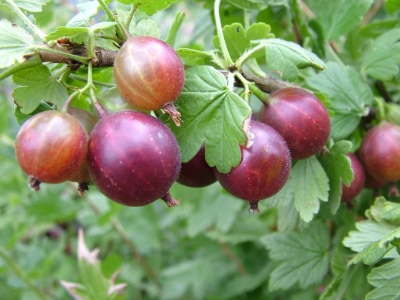
- Authors: Russia
- Appeared when crossing: (E. Lefora x African) x Weak Spiked-2
- Growth type: medium-sized
- Description of the bush: compact
- Thorniness: weak
- Thorns: single, short
- Berry size: medium size
- Berry weight, g: 4-5
- Berry shape: rounded oval
- Berry color: bright red
When choosing gooseberries for planting in their summer cottage, the gardener prefers high-yield varieties that quickly adapt to climatic characteristics and do not require special care skills. It is to these that the mid-early variety Yubilyar of Russian selection belongs.
Breeding history
Gooseberry Yubilyar is the brainchild of domestic breeders of the South Ural Research Institute of Gardening and Potato Growing, created more than half a century ago. The berry appeared by crossing several species - Weak-spiked-2 and (E. Lefora x African). The gooseberry joined the ranks of the State Register of Breeding Achievements in 1965. Recommended for growing berry bushes in the Central Black Earth region.
Description of the variety
The jubilee is a medium-sized shrub, stretching up to 150 cm, sometimes up to 180 cm. The compact bush has sprawling, erect, dark gray shoots, moderate thickening with green leaves with a glossy coating and a strong root system that penetrates deep into the ground. Sharp thorns are rarely located along the entire length of perennial shoots. During the flowering period, which begins in mid-May and lasts 6-8 days, the shrubs are densely covered with cone-shaped lavender flowers, emitting a light aroma.
The variety is self-pollinated, therefore it does not need donor shrubs, but, according to experienced gardeners, if pollinating bushes are planted on the site, the yield indicators will increase by 20-25%. The best donor shrubs are: Krasnoslavyansky, Medovy, Donetsk firstborn and Mayak.
The purpose of the gooseberry is universal - it is eaten fresh, added to compotes, processed into preserves and jams, and also frozen. After harvesting, the bushes easily tolerate transportation and can be stored in a cool place for 3 to 8 days without losing their taste and marketability. When ripe, gooseberries do not crumble or bake under the scorching sun.
Characteristics of berries
The jubilee is a medium-sized variety. The average weight of the berries is 4-5 grams. The shape of the berries is correct - round-oval with a smooth surface covered with a waxy film. Ripe gooseberries are covered with a bright red color. Sometimes, on the sunny side, the color is somewhat darker. The peel is thin with light subcutaneous veins, but strong, so the berries do not crack.
Taste qualities
Excellent taste is one of the advantages of the Yubilyar gooseberry. The yellow pulp of the berries is endowed with a loose and delicate structure, multi-seeded and very juicy. The taste is dominated by sweetness, but not sugary, perfectly combined with the slight sourness that the skin gives. The gooseberry has a pronounced dessert aroma.
Ripening and fruiting
The Anniversary belongs to the medium early species. The shrub begins to bear fruit 2-3 years after planting. Fruiting is stable and annual. Gooseberry tasting is available from the last week of July. Berries are spiced at the same time. The ability to bear fruit in the bush lasts for 14-18 years.
Yield
The yield indicators for this species are very good. With proper care and a favorable climate, up to 8 kg of ripe berries can be removed from 1 bush per season.
Landing
You can plant a seedling in autumn and spring. For autumn planting, the end of September - the beginning of October (30-45 days before stable frosts) is considered the best.If you plant a bush in the spring, then this must be done before the buds swell.
The optimal is a two-year-old seedling with a developed rhizome and 2-3 strong shoots, 20-25 cm high. When planting, it is recommended to maintain a certain distance between plantings: from trees - 2-3 m, and from other shrubs - 1-1.5 meters.

Growing and care
Gooseberries do not need special agricultural techniques, but they are picky about the planting site and the quality of the soil. It is recommended to choose a plot flat, slightly on a hill, with deep groundwater. In addition, there should be a lot of sunlight on the site. It is desirable that the shrubs be protected from drafts and strong winds.
As for the soil, black soil or loam with a neutral acidity level is suitable. The shrub soil loves loose, breathable, moisture-permeable and fertile.
Comprehensive care of berry crops consists of a number of measures: watering, loosening and mulching the soil, fertilizing, sanitary pruning of branches, as well as the prevention of diseases and pests. In addition, the shrubs require annual thinning as they grow very quickly. For the winter, the branches of the bushes should be tightly pulled together with a rope, and the near-root zone should be covered with sawdust or dry foliage.
It is recommended to propagate the variety by root layers. This procedure is carried out in the spring - in April. A healthy branch is laid on the ground and well sprinkled with earth. During the summer, vegetation (greenery) appears in some places of the branch.



Disease and pest resistance
The gooseberry has a strong immune system, so the plant is not exposed to powdery mildew. The culture is also not very attractive to insect pests. The only thing that the bush rarely suffers from is the invasion of the gooseberry caterpillar, which will help to get rid of it with special preparations.

In order for the gooseberry to produce a good harvest, it is necessary to devote time to disease prevention.
Resistance to adverse climatic conditions
Due to its resistance to stress, the shrub is not afraid of sudden temperature changes, light shade and heat. The variety is frost-resistant, withstands temperature drops down to -30-32 degrees. The only thing that gooseberries react negatively to is prolonged drought. With a long drought, the crop's yield falls, and the berries become smaller.




































































